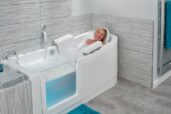As we get older and less mobile, living independently can become more of a challenge. One of the key aspects of living safely and comfortably at home is being able to take care of our personal hygiene. A well-designed bathroom that is adapted to the needs of older people is therefore a crucial element of the home.
Here are some ideas for planning a bathroom that is suitable for users with restricted mobility. Even if an accessible bathroom is not an essential requirement for you at the moment, futureproofing your bathroom is a great investment and can give you the peace of mind that you will be able to live in your own home for many years to come.
Walk-in baths
For many of us, a soak in the bathtub is one of life’s pleasures. It is also a way of easing the pain of aching muscles and joints, and reducing swelling and stiffness in the limbs. However, stepping over the side of the tub can become more difficult as we get older, and falls in the bath are one of the most common causes of household injuries.
A walk-in bath provides a convenient solution to this problem. They have a door fitted into the side so the bather can step in and out easily. They are available in full-length or compact sizes. For example, some walk-in baths are half the size of a standard tub, but have extra depth and a fitted seat, so that the bather can enjoy maximum comfort.
Heated seats are available to prevent the bather from becoming too cold while they wait for the bath to fill and drain. For an extra safety measure, grab rails can be fitted on the wall alongside the bath to provide support while standing and lowering into the bath seat.
Raised toilets
Comfort height toilets that are higher than most standard toilets make it easier for less mobile people to sit down and get up off the seat. They can be accompanied by a grab rail at the side of the toilet for extra support.
Walk-in showers
A shower which is easily accessible is a must-have feature for independent living. A simple space saving solution is to have a shower fitted over an L-shaped or P-shaped bath. If the user finds standing up for prolonged periods too difficult, this can be used with an adaptable shower seat.
More spacious bathrooms may have room for a walk-in shower, which has a low-profile shower tray. Additional features, such as anti-scald temperature controls, remote touch-free technology, and riser rails, are available.
Modern digital showers can be programmed to have a fixed temperature and turn off after a preset time period, to help users who have difficulty manipulating the controls.
If you are interested in finding out more information about showers for elderly and disabled, please call us on 01491 411041 or visit our website.
8 April,2023








